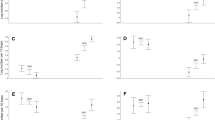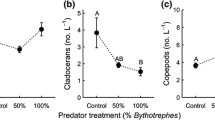Abstract
Predation, competition, and their interaction are known to be important factors that influence the structure of ecological communities. In particular, in those cases where a competitive hierarchy exists among prey species, the presence of certain keystone predators can result in enhanced diversity in the prey community. However, little is known regarding the influence of keystone predator presence on invaded prey communities. Given the widespread occurrence of invasive species and substantial concern regarding their ecological impacts, studies on this topic are needed. In this study I used naturalistic replications of an experimental tadpole assemblage to assess the influence of predatory eastern newts, Notophthalmus viridescens, on the outcome of interspecific competition among native and nonindigenous tadpoles. When newts were absent, the presence of the tadpoles of one invasive species, the Cuban treefrog, Osteopilus septentrionalis, resulted in decreased survival and growth rate of the dominant native species, Bufo terrestris, and dominance of the tadpole assemblage by O. septentrionalis. However, the presence of one adult newt generally reduced or eliminated the negative impacts of O. septentrionalis tadpoles, resulting in comparable survival and performance of native species in invaded and noninvaded treatments. Differential mortality among the tadpole species suggests that newts preyed selectively on O. septentrionalis tadpoles, supporting the hypothesis that newts acted as keystone predators in the invaded assemblage. The presence of nonindigenous larval cane toads, Bufo marinus, did not significantly affect native species, and this species was not negatively affected by the presence of newts. Collectively, these results suggest that eastern newts significantly modified the competitive hierarchy of the invaded tadpole assemblage and reduced the impacts of a competitively superior invasive species. If general, these results suggest that the presence of certain species may be an essential factor regulating the ecological impacts of biological invasions.


Similar content being viewed by others
References
Attar EN, Maly EJ (1980) A laboratory study of preferential predation by the newt Notophthalmus v. viridescens. Can J Zool 58:1712–1717
Bartlett RD, Bartlett PP (1999) A field guide to Florida reptiles and amphibians. Gulf, Houston
Berven KA (1981) Mate choice in the wood frog, Rana sylvatica. Evolution 35:707–722
Berven KA, Gill DE (1983) Interpreting geographic variation in life-history traits. Am Zool 23:85–97
Crossland MR, Alford RA (1998) Evaluation of the toxicity of eggs, hatchlings and tadpoles of the introduced toad Bufo marinus (Anura: Bufonidae) to native Australian aquatic predators. Aust J Ecol 23:129–137
Crossland MR, Azevedo-Ramos C (1999) Effects of Bufo (Anura: Bufonidae) toxins on tadpoles from native and exotic Bufo habitats. Herpetologica 55:192–199
Crump ML (1986) Cannibalism by younger tadpoles: another hazard of metamorphosis. Copeia 1986(4):1007–1009
D’Antonio CM, Levine JM (1999) Elton revisited: a review of evidence linking diversity and invasibility. Oikos 87:15–26
Davic RD (2003) Linking keystone species and functional groups: a new operational definition of the keystone species concept. Conserv Ecol 7:r11
Elton CS (1958) The ecology of invasions by animals and plants. Methuen, London
Fauth JE (1999) Identifying potential keystone species from field data—an example from temporary ponds. Ecol Lett 2:36–43
Fauth JE, Resetarits WJ (1991) Interactions between the salamander Siren intermedia and the keystone predator Notophthalmus viridescens. Ecology 72:827–838
Gosner KL (1960) A simplified table for staging anuran embryos and larvae with notes on identification. Herpetologica 16:183–190
Hintze J (2001) Number cruncher statistical systems. http://www.ncss.com/
Kotliar NB (2000) Application of the new keystone-species concept to prairie dogs: how well does it work? Conserv Biol 14:1715–1721
Mack RN, Simberloff D, Lonsdale WM, Evans H, Clout M, Bazzaz FA (2000) Biotic invasions: causes, epidemiology, global consequences, and control. Ecol Appl 10:689–710
Menge BA, Berlow EL, Blanchette CA, Navarrete SA, Yamada SB (1994) The keystone species concept: variation in interaction strength in a rocky intertidal habitat. Ecol Monogr 64:249–286
Meshaka WE Jr (2001) The Cuban treefrog: life history of a successful colonizing species. University Press of Florida, Gainesville, FL
Meshaka WE Jr, Butterfield BP, Hauge JB (2004) The exotic amphibians and reptiles of Florida. Krieger, Malabar, FL
Mills LS, Soule ME, Doak DF (1993) The keystone-species concept in ecology and conservation. Bioscience 43:219–224
Morin PJ (1981) Predatory salamanders reverse the outcome of competition among three species of anuran tadpoles. Science 212:1284–1286
Morin PJ (1983) Predation, competition, and the composition of larval anuran guilds. Ecol Monogr 53:119–138
Nicieza AG (2000) Interacting effects of predation risk and food availability on larval anuran behaviour and development. Oecologia 123:497–505
Paine RT (1966) Food web complexity and species diversity. Am Nat 100:65–75
Paine RT (1969) A note on trophic complexity and community stability. Am Nat 103:91–93
Power ME et al (1996) Challenges in the quest for keystones. Bioscience 46:609–620
SAS (2004) JMP 5.1.1. http://www.jmp.com/
Schmitz OJ (2003) Top predator control of plant biodiversity and productivity in an old-field ecosystem. Ecol Lett 6:156–163
Simberloff D (1995) Why do introduced species appear to devastate islands more than mainland areas? Pacific Sci 49:87–97
Simberloff D (1997) The biology of invasions. In: Simberloff D, Schmitz DC, Brown TC (eds) Strangers in paradise. Island, Washington, D.C., pp 3–17
Smith DC (1987) Adult recruitment in chorus frogs: effects of size and date at metamorphosis. Ecology 68:344–350
Smith KG (2005a) Effects of non-indigenous tadpoles on native tadpoles in Florida: evidence of competition. Biol Conserv 123:433–441
Smith KG (2005b) An exploratory assessment of Cuban treefrog (Osteopilus septentrionalis) tadpoles as predators of native and non-indigenous tadpoles in Florida. Amphib-Reptil 26:571–575
Sokal RR, Rohlf FJ (1995) Biometry, 3rd edn. Freeman, New York
Travis J (1980) Phenotypic variation and the outcome of interspecific competition in hylid tadpoles. Evolution 34:40–50
Werner EE (1992) Competitive interactions between wood frog and northern leopard frog larvae: the influence of size and activity. Copeia 1992:26–35
Wilbur HM (1980) Complex life cycles. Annu Rev Ecol Syst 11:67–93
Wilbur HM (1987) Regulation of structure in complex systems: experimental temporary pond communities. Ecology 68:1437–1452
Wilbur HM, Fauth JE (1990) Experimental aquatic food webs: interactions between two predators and two prey. Am Nat 135:176–204
Wilcove DS, Rothstein D, Dubow J, Phillips A, Losos E (1998) Quantifying threats to imperiled species in the United States. Bioscience 48:607–615
Woolbright LL (1983) Sexual selection and size dimorphism in anuran Amphibia. Am Nat 121:110–119
Acknowledgements
I thank C. K. Dodd and A. C. Echternacht for guidance and support throughout this project. W. J. Barichivich, K. F. Noble, and J. S. Staiger provided significant logistic and personal support and assisted with field and laboratory work. L. I. Casey and J. E. Earl helped monitor the experiments and collect data. M. L. Beals, C. K. Dodd, A. C. Echternacht, M. S. Gunzburger, D. Simberloff, and two anonymous reviewers commented on the manuscript. Lerio Corporation donated the vinyl tanks used in this research. This research was funded primarily by a U.S. Geological Survey Cooperative Ecosystem Study Unit agreement grant. The University of Tennessee Graduate School and Department of Ecology and Evolutionary Biology provided additional financial support for this project. This research was conducted in accordance with all applicable laws and was approved by the University of Tennessee IACUC, protocol # 1246.
Author information
Authors and Affiliations
Corresponding author
Additional information
Communicated by David Post
Rights and permissions
About this article
Cite this article
Smith, K.G. Keystone predators (eastern newts, Notophthalmus viridescens) reduce the impacts of an aquatic invasive species. Oecologia 148, 342–349 (2006). https://doi.org/10.1007/s00442-006-0370-y
Received:
Accepted:
Published:
Issue Date:
DOI: https://doi.org/10.1007/s00442-006-0370-y




